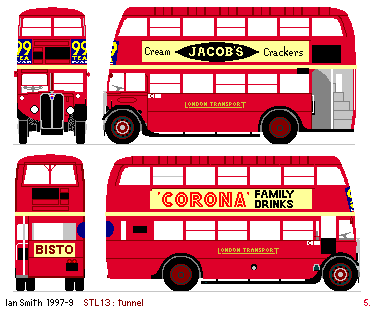
This page created 1997, updated 10th July 2002 The Tunnel STLsThe Tunnel STLs, 4/9STL13 (total 40) The Blackwall Tunnel under the Thames
had a small bore and sharp bends, requiring special double-deckers.
The special NSs that had operated the routes were life-expired,
and a batch of Tunnel STLs was produced, with roofs to a special profile,
and tapered rear ends.
They also had tyres with reinforced walls to protect them from frequent contact
with the tunnels' kerbs. The chassis were interchangeable with the other
roofbox STLs, and they were numbered randomly into the main sequence.
The special profile reduced headroom at the sides of the top deck,
so the staircase was continued round semicircularly to emerge at the gangway.
This caused the loss of one of the single seats upstairs: the one which usually
fitted into the angle of the stair-well, reducing their capacity to 55 (26+29).
The Blackwall Tunnel under the Thames
had a small bore and sharp bends, requiring special double-deckers.
The special NSs that had operated the routes were life-expired,
and a batch of Tunnel STLs was produced, with roofs to a special profile,
and tapered rear ends.
They also had tyres with reinforced walls to protect them from frequent contact
with the tunnels' kerbs. The chassis were interchangeable with the other
roofbox STLs, and they were numbered randomly into the main sequence.
The special profile reduced headroom at the sides of the top deck,
so the staircase was continued round semicircularly to emerge at the gangway.
This caused the loss of one of the single seats upstairs: the one which usually
fitted into the angle of the stair-well, reducing their capacity to 55 (26+29).
When first delivered in March/April 1937 the first few went to Holloway (J) and Hackney (H), while Athol Street, (C) was made ready for diesel buses but very soon all the class were congregated there (or at Camberwell, Q). The Tunnel STLs were always associated with routes 108, 108A (Poplar - Blackwall Tunnel - Eltham / Woolwich or Crystal Palace), although they also appeared on the 82 via the Rotherhithe Tunnel. As there were more buses (40) than duties (32) on the two tunnel routes they also appeared on other docklands routes from Athol Street. The 108 route number is now associated with the Blackwall Tunnel in local folklore, such as saying "Watch out, here comes a 108" to someone who yawns widely!
The Tunnel STLs spent almost all their working lives at Athol Street garage in Poplar (C),
- and long working lives they were too. They outlived most of their contemporaries,
as the RT family had no equivalent. It was only when the tunnel was altered in 1953
that they lost their monopoly: normal-height STLs and RTLs began to appear on the 108 during 1953,
and the last "tunnel STLs" went early in 1954.
|
 During the war they had a display oddity,
in that they were allowed two front apertures (both reduced),
one for the route number and the other for the destination and via points.
Most of the buses retained their tunnel bodies through overhauls,
but wartime bombing in the docklands saw three bodies severely damaged.
One was a write-off, but two were heavily rebuilt and appeared later on other chassis.
The surviving chassis received replacement non-tunnel bodies and were pressed back into service.
STL 2437 received one of the repaired bodies in 1941,
and in 1944 STL 834 acquired the other,
which was distinguishable by having non-opening front windows.
During the war they had a display oddity,
in that they were allowed two front apertures (both reduced),
one for the route number and the other for the destination and via points.
Most of the buses retained their tunnel bodies through overhauls,
but wartime bombing in the docklands saw three bodies severely damaged.
One was a write-off, but two were heavily rebuilt and appeared later on other chassis.
The surviving chassis received replacement non-tunnel bodies and were pressed back into service.
STL 2437 received one of the repaired bodies in 1941,
and in 1944 STL 834 acquired the other,
which was distinguishable by having non-opening front windows.
 the tunnel bus histories
the tunnel bus histories Bus Stop
Bus Stop contents
contents roofbox
roofbox Tunnel
Tunnel